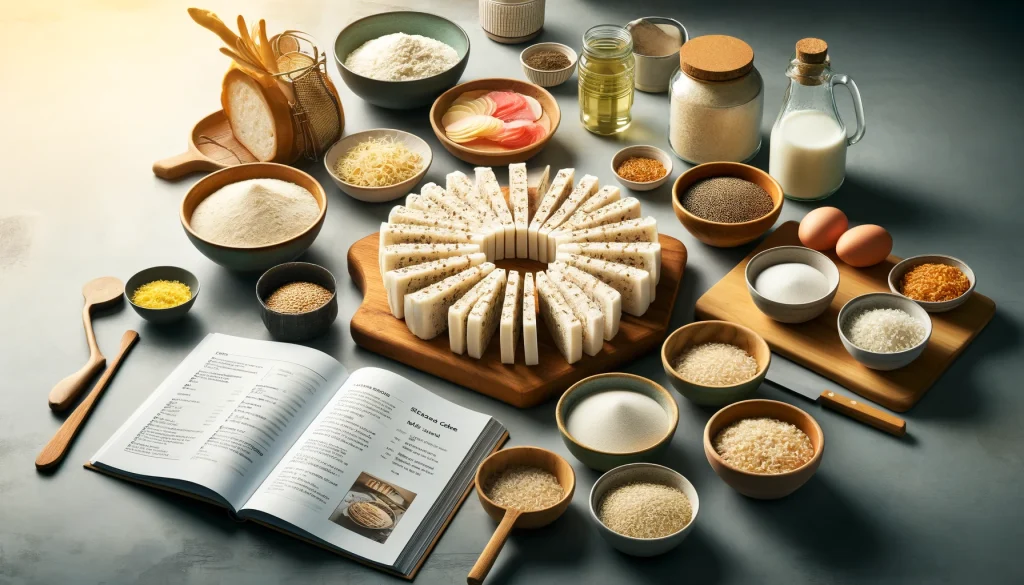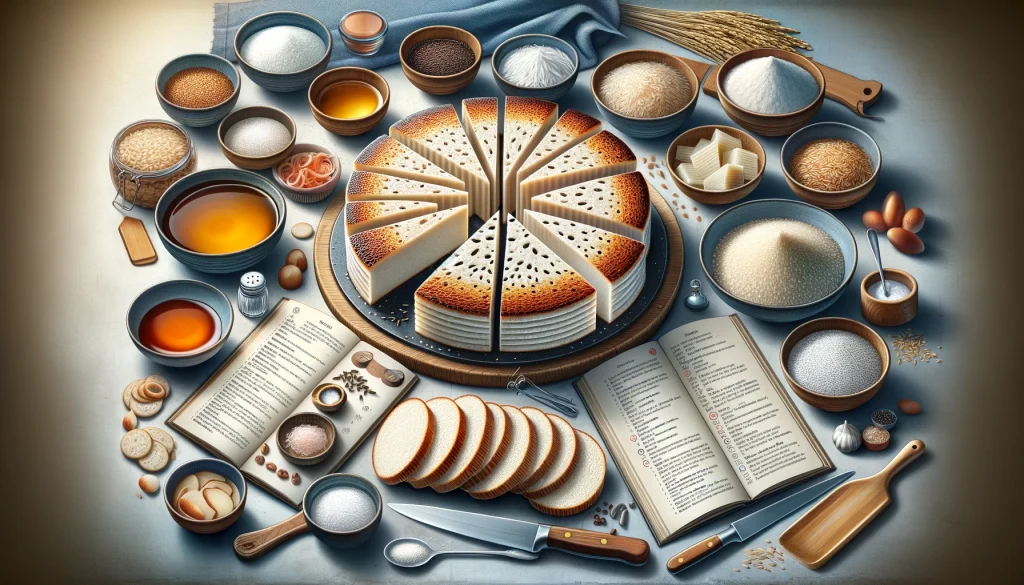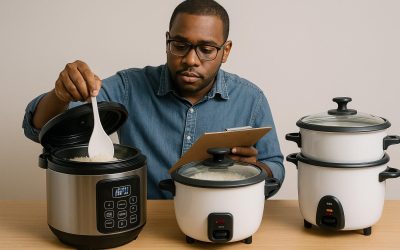As an Amazon Associate I earn from qualifying purchases.
Sliced rice cakes, a quintessential element in the tapestry of Asian culinary traditions, offer a unique blend of simplicity and versatility that captivates the palate of food enthusiasts around the world. Known for their delightfully chewy texture and ability to absorb the flavors of their accompanying ingredients, these rice cakes serve as a cornerstone for a myriad of dishes, ranging from the fiery tteokbokki of Korea to the soothing tteokguk enjoyed during Lunar New Year celebrations. This guide aims to demystify the process of making sliced rice cakes from scratch, inviting both novices and seasoned cooks to embark on a culinary journey that bridges cultures and flavors.
At the heart of sliced rice cakes lies glutinous rice flour, transformed through the alchemy of steaming and shaping into a versatile ingredient that is as much about texture as it is about taste. Whether you’re looking to explore the spicy, savory, or sweet spectrums of Asian cuisine, these rice cakes offer a canvas ready to be painted with the vibrant hues of your culinary imagination. From the bustling streets of Seoul to the quiet kitchens across the globe, the journey of making and enjoying sliced rice cakes is a testament to the enduring appeal of this simple yet profound food tradition.
In the following sections, we will explore the step-by-step process of creating sliced rice cakes, share expert tips for achieving the perfect chewy texture, and suggest ways to incorporate them into a variety of dishes. Whether you’re aiming to recreate a taste of home or to experiment with new flavors, mastering the art of making sliced rice cakes promises a rewarding and delicious adventure.
Sliced Rice Cake Recipe

Sliced rice cakes, often referred to as “tteok” in Korean cuisine, are versatile and can be used in various dishes, from spicy stir-fries to comforting soups. However, if you’re looking to make a basic sliced rice cake from scratch, you might be thinking of something akin to “garaetteok,” a type of Korean rice cake that’s commonly used in dishes like tteokbokki (spicy rice cake stir-fry) or tteokguk (rice cake soup). Here’s a simple recipe to make your own sliced rice cakes at home.
Ingredients:
- 2 cups of sweet rice flour (also known as glutinous rice flour)
- 3/4 cup of water (adjust as needed)
- 1/2 teaspoon of salt
- Cornstarch or potato starch, for dusting
Equipment:
- Steamer
- Mixing bowl
- Spatula
- Knife for slicing
- Rolling pin (optional)
Instructions:
Prepare the Dough:
- In a mixing bowl, combine the sweet rice flour and salt. Gradually add water and mix until a dough forms. The dough should be pliable but not sticky. Adjust the water or flour as necessary to achieve the right consistency.
Shape the Dough:
- Knead the dough briefly, then form it into a log or a shape that will fit your steamer. You can also divide the dough into smaller pieces for individual rice cakes.
Steam the Rice Cake:
- Prepare your steamer by bringing the water to a boil. Place the dough in the steamer, making sure it’s not touching the water directly. Cover and steam for about 20 minutes. The dough will become translucent and significantly firmer when it’s done.
Cool and Slice:
- Let the steamed rice cake cool completely before handling. Once cooled, dust a cutting board and the rice cake with cornstarch or potato starch to prevent sticking. Use a sharp knife to slice the rice cake into your desired thickness. Dust the slices with a bit more starch to ensure they don’t stick together.
Serve or Store:
- Your sliced rice cakes are now ready to be used in various dishes. If you’re not using them immediately, store them in an airtight container. They can be kept at room temperature for a day or refrigerated for up to a week. For longer storage, freeze them with layers of parchment paper in between to prevent sticking.
Tips:
- Adjust Water Gradually: Depending on the brand of sweet rice flour you use, you may need to adjust the amount of water slightly. Start with less and add more as needed.
- Steaming Time May Vary: The size and thickness of your rice cake log can affect steaming time. Check for doneness by inserting a toothpick into the center; it should come out clean.
- Serving Suggestions: Sliced rice cakes can be stir-fried with vegetables and protein in a spicy sauce for tteokbokki, added to soups like tteokguk, or even grilled and served with a dipping sauce.
This basic recipe offers a gateway into enjoying homemade sliced rice cakes, ready to be incorporated into a variety of dishes that celebrate the chewy, comforting texture of this beloved ingredient.
Expert Tips

Creating the perfect sliced rice cake, especially in the context of Korean cuisine (e.g., garaetteok), requires attention to detail and a few expert tips to elevate the texture and flavor. Here are some insights to help you master the art of making sliced rice cakes:
1. Quality of Rice Flour
- The quality of sweet rice flour (glutinous rice flour) significantly affects the texture of the rice cakes. Opt for high-quality, freshly milled flour if possible. Korean brands often yield the best results for traditional Korean dishes.
2. Water Temperature
- The temperature of the water mixed with the rice flour can impact the dough’s texture. Warm water can help the flour to absorb more effectively, leading to a smoother dough. However, adjust based on the specific recipe, as some may call for cold water to achieve a certain texture.
3. Kneading the Dough
- Properly kneading the dough is crucial. Knead until the dough is smooth and pliable. This ensures that the rice cakes have a uniform texture without any hard spots or cracks after steaming.
4. Consistent Thickness
- When shaping the dough before steaming, aim for consistent thickness throughout the log. This not only ensures even cooking but also makes slicing easier and more uniform, which is particularly important when using the slices in dishes where cooking time is crucial.
5. Steaming Process
- Ensure your steamer setup allows for ample steam circulation. A tightly sealed steamer lid is essential to maintain an even and constant steam flow. Also, lining the steamer with cheesecloth or a similar material can prevent the dough from sticking while allowing steam to pass through effectively.
6. Cooling Before Slicing
- Allow the steamed rice cake to cool completely to room temperature before slicing. This cooling process helps the rice cake firm up, making it easier to slice cleanly without sticking or squishing.
7. Storing Techniques
- If not using immediately, sliced rice cakes should be stored properly to maintain their texture. For short-term storage, place them in an airtight container with a piece of parchment paper between layers to prevent sticking. For long-term storage, freeze them in the same manner. Thaw overnight in the refrigerator or briefly in the microwave before use.
8. Reviving Rice Cakes
- If your rice cakes have hardened, briefly soak them in water before cooking. This rehydrates the rice cakes and brings back their chewy texture. Be cautious not to soak for too long, as they can become too soft and lose their structure.
9. Experiment with Flavors
- While traditional sliced rice cakes are plain, adding subtle flavorings to the dough, such as a pinch of salt, sesame oil, or incorporating finely ground nuts, can offer a unique twist without overpowering the dish they are added to.
10. Practice Makes Perfect
- The texture and consistency of the dough can be tricky to master on the first try. Don’t be discouraged by initial attempts; each batch will improve your technique and understanding of the process.
These expert tips should guide you in making high-quality sliced rice cakes that can be enjoyed in a myriad of dishes, from the spicy and savory to the warm and comforting. Remember, the key to perfecting traditional recipes lies in patience, practice, and a willingness to learn from each attempt.
Why This Recipe Is Just So Good…
The sliced rice cake recipe, particularly when referring to traditional Korean garaetteok or similar types used in various Asian cuisines, holds a special allure for several reasons. This delight transcends simple culinary boundaries, offering a unique combination of texture, versatility, and cultural significance that contributes to its widespread popularity. Here are some reasons why this recipe is so cherished:
1. Unique Texture
- The hallmark of sliced rice cakes is their wonderfully chewy and satisfying texture. The glutinous rice flour creates a mochi-like consistency that’s neither too hard nor too soft, providing a pleasing mouthfeel that’s hard to find in other foods. This texture plays a crucial role in the dishes they are part of, adding a distinctive chewiness that enhances the overall eating experience.
2. Versatility in Cooking
- Sliced rice cakes are incredibly versatile, serving as a neutral base that absorbs the flavors of whatever they’re cooked with. They can be incorporated into a wide range of dishes, from the spicy and savory tteokbokki, enriched with gochujang (Korean chili paste), to the comforting and mild tteokguk, a soup traditionally eaten during the Korean New Year. Their ability to complement both sweet and savory ingredients makes them a staple in Korean cuisine and beyond.
3. Cultural Significance
- For many, these rice cakes are more than just food; they’re a connection to cultural traditions and celebrations. In Korea, for example, tteok (rice cakes) are central to various festivities and milestones, symbolizing prosperity, longevity, and the start of new beginnings. Making and sharing these rice cakes deepens bonds between families and communities, embedding them with memories and significance that go beyond their taste.
4. Nutritional Value
- Made primarily from glutinous rice flour, sliced rice cakes are a source of carbohydrates that provide energy throughout the day. They’re also gluten-free, making them a suitable option for those with gluten sensitivities or celiac disease. When paired with vegetables and protein in dishes, they contribute to a balanced meal.
5. Simplicity and Satisfaction
- Despite their seemingly intricate texture, sliced rice cakes are relatively simple to make from scratch, requiring minimal ingredients. This simplicity, coupled with the hands-on experience of kneading and shaping the dough, offers a sense of satisfaction and accomplishment. The joy of creating something so delicious from basic components adds to the overall appeal of the recipe.
6. Adaptability to Modern Tastes
- While deeply rooted in tradition, sliced rice cakes have seamlessly adapted to contemporary tastes and culinary trends. Chefs and home cooks alike experiment with innovative fillings, sauces, and cooking methods, constantly reinventing ways to enjoy this classic ingredient, ensuring its continued relevance and popularity among new generations.
In essence, the sliced rice cake recipe embodies a perfect blend of texture, versatility, and cultural depth, making it a beloved choice for many. Its ability to connect past and present, traditional and modern, makes it not just good, but a cherished part of culinary heritage.
Storage Instructions
Proper storage of sliced rice cakes is essential to maintain their texture and freshness, whether they’re homemade or store-bought. Here are detailed instructions for storing sliced rice cakes effectively:
Short-Term Storage
- Room Temperature: Freshly made sliced rice cakes can be kept at room temperature for about a day. Ensure they are tightly wrapped in plastic wrap or placed in an airtight container to prevent them from drying out.
- Refrigeration: For a slightly longer storage period, you can refrigerate sliced rice cakes. Wrap them in plastic wrap and place them in an airtight container. Refrigerated rice cakes can last for up to a week. However, they may harden over time, so it’s best to consume them as soon as possible for optimal texture.
Long-Term Storage
- Freezing: Sliced rice cakes freeze exceptionally well, making this an excellent option for long-term storage. To freeze, first let the rice cakes cool completely if they are freshly made. Wrap them individually or in small portions with plastic wrap, then place them in a freezer bag or an airtight container. Be sure to squeeze out as much air as possible to prevent freezer burn. Frozen sliced rice cakes can last for several months.
- Thawing: When you’re ready to use frozen rice cakes, it’s best to thaw them gradually. Transfer them from the freezer to the refrigerator and let them thaw overnight. For a quicker thawing method, you can soak them in cold water for a few hours, or directly add them to your cooking dish, and they will thaw as they cook.
Refreshing Rice Cakes
- Reviving Hardened Rice Cakes: If your rice cakes have hardened in the refrigerator or after thawing, there are a couple of ways to revive them. One method is to soak them in water for a few minutes before cooking. Alternatively, you can steam them for about 5 minutes or microwave them with a wet paper towel covering them for about 30 seconds to 1 minute. These methods help restore the rice cakes’ soft, chewy texture.
Tips for Best Results
- Label and Date: When freezing rice cakes, it’s helpful to label the freezer bag or container with the date of storage. This helps you keep track of how long they have been frozen and use them within an optimal timeframe.
- Avoid Repeated Freezing and Thawing: Try to avoid freezing, thawing, and refreezing rice cakes, as this can affect their texture and quality. It’s best to store them in portions that you’ll use in one cooking session.
By following these storage instructions, you can ensure that your sliced rice cakes remain delicious and retain their texture, ready to be enjoyed in your favorite dishes whenever you like.
Frequently Asked Questions (FAQ)

Creating and enjoying sliced rice cakes, particularly in the context of dishes like tteokbokki or tteokguk, involves understanding not only the recipe but also how to store them properly and address common concerns. Here are some expertise questions and answers that might arise when dealing with sliced rice cake recipes:
Q: What are sliced rice cakes made of?
A: Sliced rice cakes are made from glutinous rice flour, which gives them their characteristic chewy texture. The dough is formed into a log, steamed, and then sliced into pieces.
Q: Can I make sliced rice cakes without glutinous rice flour?
A: Glutinous rice flour is essential for achieving the authentic chewy texture of rice cakes. Substituting it with regular rice flour or other types of flour would not yield the same results.
Q: How can I prevent the rice cakes from sticking together after slicing?
A: Dust the rice cakes with a bit of rice flour or cornstarch after slicing. This will help prevent them from sticking together, especially if you plan to store them.
Q: How long can I store sliced rice cakes and how?
A: Sliced rice cakes can be stored in the refrigerator for up to a week or in the freezer for up to two months. Make sure to place them in an airtight container or a zip-lock bag to prevent them from drying out. If frozen, they don’t need to be thawed before cooking; they can go directly into the dish you’re preparing.
Q: Why do my rice cakes turn out hard or not chewy enough?
A: This could be due to under-steaming the rice cake log, not kneading the dough enough, or using an incorrect ratio of water to glutinous rice flour. Make sure to steam the rice cake until it’s fully cooked through and has a translucent appearance. Also, kneading the dough thoroughly is crucial for developing the right texture.
Q: Can sliced rice cakes be used in both sweet and savory dishes?
A: Yes, sliced rice cakes are incredibly versatile and can be used in both sweet and savory dishes. They’re commonly used in savory dishes like tteokbokki (spicy rice cake stir-fry) and tteokguk (rice cake soup) but can also be used in sweet dishes, often served with syrup or sugar.
Q: How do I cook frozen sliced rice cakes?
A: Frozen sliced rice cakes do not need to be thawed before cooking. You can add them directly to soups or stir-fries. If you’re concerned about them sticking together, briefly rinse them under cold water before adding them to your dish.
Q: Are rice cakes gluten-free?
A: Yes, rice cakes made from glutinous rice flour are naturally gluten-free, making them a great option for those with gluten sensitivities or celiac disease. However, always check the labels of any additional ingredients to ensure they are also gluten-free.
Q: Can I flavor the rice cake dough?
A: While traditional sliced rice cakes are usually plain to complement the flavors of the dishes they’re added to, you can experiment by adding subtle flavors to the dough, such as matcha powder for a green tea flavor or a bit of beet juice for color and a slight sweetness.
Q: My rice cakes are too chewy/tough after cooking. What went wrong?
A: This could be due to overcooking the rice cakes in the dish or using rice cakes that were not properly stored and have dried out. It’s important to monitor the cooking time closely, as it doesn’t take long for rice cakes to heat through and become soft. For dried out rice cakes, soaking them in water for a bit before cooking can help revive their texture.
Q: How should I store fresh sliced rice cakes to maintain their texture?
A: Freshly made sliced rice cakes should be allowed to cool to room temperature first. Once cooled, they can be stored in an airtight container or zip-lock bag. For short-term storage, place them in the refrigerator, where they can last for about a week. For long-term storage, freeze them, ensuring they are separated by parchment paper to prevent sticking. Frozen rice cakes can last for several months and can be cooked directly from frozen, adding only a minute or two to the cooking time.
Q: My rice cakes have hardened in the fridge. How can I soften them?
A: Hardened rice cakes can be rejuvenated by briefly soaking them in warm water for about 10-20 minutes or until they are soft to the touch. Be careful not to soak them for too long, as they might become mushy. Alternatively, you can steam them for a few minutes until they are soft again. If you’re in a rush, microwaving them with a damp paper towel over them for 30 seconds to a minute can also restore their chewiness.
Q: Can I make sliced rice cakes without a steamer?
A: Yes, if you don’t have a traditional steamer, you can use a makeshift steaming setup. Fill a pot with a small amount of water, place a colander or a heat-resistant dish on top (ensuring it doesn’t touch the water), and cover it with a lid. The goal is to allow the steam to cook the rice cake evenly without it coming into direct contact with the water.
Q: How can I ensure my sliced rice cakes don’t stick together when I freeze them?
A: To prevent sticking, dust each sliced rice cake lightly with rice flour or cornstarch before freezing. Arrange them in a single layer on a baking sheet lined with parchment paper and freeze until solid. Once frozen, you can transfer them to a freezer bag or container. This method also makes it easy to take out only the amount you need without defrosting the entire batch.
Q: Is there a difference between using freshly made rice cakes and store-bought ones in recipes?
A: Freshly made rice cakes tend to be softer and chewier than store-bought ones, which can sometimes be drier or harder, affecting the final dish’s texture. Fresh rice cakes also have a subtle sweetness and aroma that can enhance a dish. However, store-bought rice cakes are a convenient and time-saving option, and soaking or steaming can help revive their texture.
Q: Are there any nutritional differences between white and brown rice cakes?
A: Brown rice cakes, made from whole grain brown rice, retain more fiber, vitamins, and minerals than their white rice counterparts, making them a slightly healthier option. However, brown rice cakes can have a firmer texture and a nuttier flavor, which might slightly alter the traditional taste and feel of the dish they are used in.
Q: Can sliced rice cakes be used in non-traditional or fusion recipes?
A: Absolutely! The neutral flavor and chewy texture of sliced rice cakes make them an excellent ingredient for culinary experimentation. They can be incorporated into various cuisines and dishes, from stir-fries and salads to skewers and even incorporated into Western dishes like soups and casseroles for an unexpected texture contrast.
These expert insights should help navigate the common challenges and questions associated with making and using sliced rice cakes, enhancing your culinary experience with this versatile ingredient.
Conclusion
Embarking on the journey of making sliced rice cakes at home is more than just a culinary endeavor; it’s a deep dive into the heart of traditional cooking, a celebration of texture and taste that transcends geographical boundaries. As we conclude this guide, it’s clear that these chewy delights are not just a staple of Asian cuisine but a versatile ingredient that can bring a unique twist to countless dishes across various culinary landscapes.
The process of transforming glutinous rice flour into these satisfying slices is a testament to the beauty of simplicity in cooking. It reminds us that with just a few basic ingredients and a touch of patience, we can create something truly special. The art of making sliced rice cakes is a bridge between the past and the present, offering a hands-on connection to traditions that have been cherished for generations while inviting innovation and personal expression.
As you incorporate these homemade rice cakes into your cooking, whether through traditional recipes like tteokbokki and tteokguk or by experimenting with new, fusion dishes, you’re not just nourishing your body but also enriching your culinary repertoire. The versatility of sliced rice cakes means the possibilities are as limitless as your imagination, allowing you to explore a world of flavors and textures.
We hope this guide has inspired you to embrace the challenge of making sliced rice cakes from scratch and to discover the joy of sharing them with friends and family. Remember, cooking is not just about the end product but the experiences and memories created along the way. So, as you continue to explore and experiment with this delightful ingredient, may your kitchen be filled with laughter, love, and the unmistakable aroma of delicious, chewy rice cakes that speak of a






